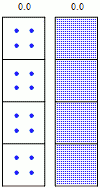3.2 Radioactive decay
One of the natural processes which best demonstrates the probabilistic nature of the quantum world is radioactive decay. This process occurs in unstable atomic nuclei. Depending on the type of decay, different particles are ejected from the nucleus, which can be detected and counted. However, the time it takes for a specific nucleus to decay cannot be predicted, regardless of how long the atom has existed. Quantum theory will only provide bigger-picture statistical predictions, like how long it takes on average for an atom to decay. While this is broadly useful information when you’re looking at many atoms at once, it can’t be used to make any predictions about individual atoms. Experimental observations confirm this. The counts from radioactive decay appear completely random, and the statistics are in agreement with quantum theory.
You may be aware of the notion of ‘half-life’, which refers to the time required for half of the atoms in your sample to decay (assuming that you have a large number of atoms to start with). Figure 9 shows a simulation of this radioactive decay, starting with either 4 atoms per box (left) or 400 (right). The number at the top records how many half-lives have elapsed.
Be careful not to get confused here: this isn’t the same as the mean lifetime of a single atom. For example, radium-226 has a half-life of 1,602 years. If you put a block of radium-226 into your drawer, the amount of radium-226 atoms in it will have halved after 1,602 years (and it will keep halving from there, so that after 3,204 years you’re left with a quarter of your original radium-226). However, if you take single radium-226 atoms, record how long they each take to decay, and take the average, you’ll find that the mean lifetime is 2,311 years. This difference has nothing to do with quantum effects – it’s just a consequence of different ways of taking an average.
Radioactive decay is used in many areas – one of which is radiocarbon dating. While most of the carbon atoms on Earth are the stable 12C atoms (carbon-12, whose nuclei have 6 protons and 6 neutrons each) and 13C atoms (whose nuclei have one additional neutron), there is a very small amount of unstable carbon atoms (about one in a trillion) whose nuclei have two additional neutrons. Measuring the amount of these 14C atoms that are left in a sample from a dead plant or animal provides information that can be used to calculate how long ago the plant or animal died. This is done by picking up and counting the signals from decaying atoms in the sample, which allows you to estimate the number of atoms of this type. Because the half-life of 14C is about 5,730 years, this method allows the reliable dating of materials up to around 50,000 years old – there are too few 14C atoms left in samples older than this, and the statistics are not good enough to draw firm conclusions.

